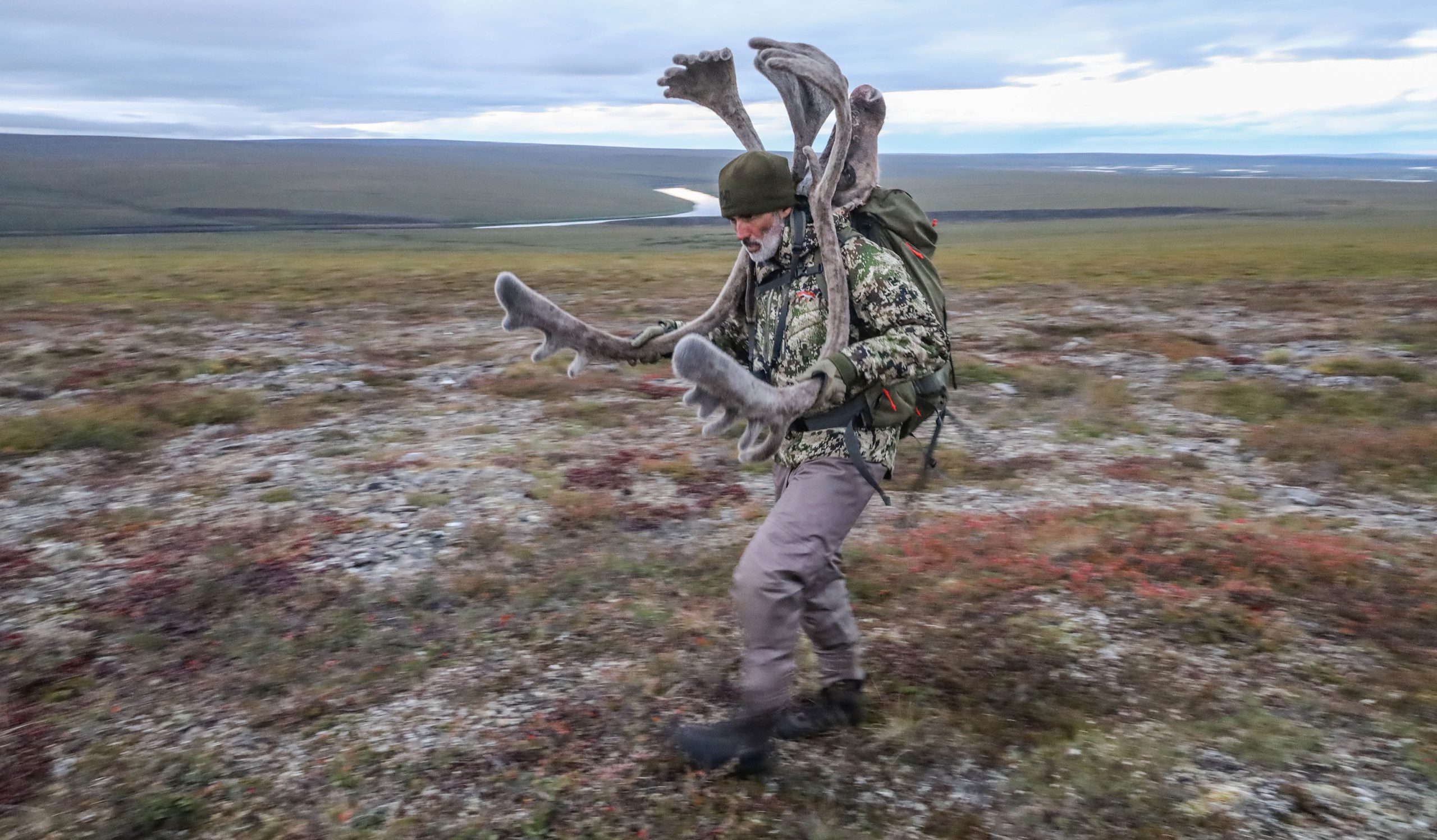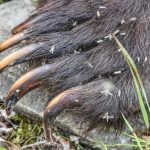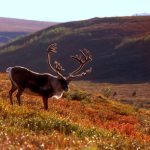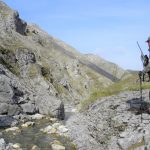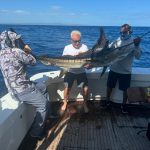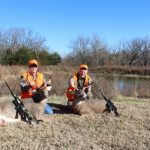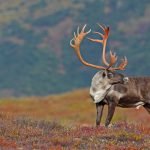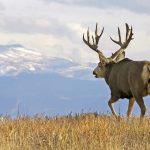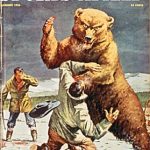A challenging and rewarding hunt in one of the most remote places on Earth.
The headwaters of the Colville River begin along the northern edge of Alaska’s Brooks Range, and from there the river runs north and east for about 350 miles before it spills into the Arctic Ocean west of Prudhoe Bay. Along its course the Colville, located entirely above the Arctic Circle, doesn’t pass anything resembling a town. When the river flows (it’s covered in ice for more than half the year), it passes through hundreds of miles of empty, treeless tundra. Researchers have named the confluence of the Colville and its tributary, the Etivluk River, the most remote place in all of North America.
After ten hours riding upstream in a Zodiac loaded with caribou-hunting gear, I had no trouble believing this was indeed the most far-flung destination on the continent. Neal Emery, who worked for Hornady at the time, rode in the bow of the boat while I was draped across guns and equipment amidships and our nineteen-year-old guide, Geordy, manned the steering column from the stern. The din of the outboard motors made talking impossible, so I spent long hours searching the hillsides for mammoth tusks, which sometimes become exposed on cliffs along the river.
The Colville–a river where it’s more common to see a woolly mammoth’s tusk than another boat. The term “remote” doesn’t accurately describe the area, a place where hunters watch as columns of storm clouds build up fifty miles away, with nowhere to escape and without a single tree under which to shelter. The storms march across the barren moonscape and dump cascading sheets of water on the huddled visitor before continuing toward the Brooks Range and the Alaskan interior. In the Arctic there’s no place to hide from the elements.
What draws hunters this deep into the tundra is the annual caribou migration. Beginning in August the Western Arctic caribou herd, which has spent the long summer days farther north around Prudhoe Bay, begins a southward migration toward the Brooks Range. If you’re in the proper place at the proper time you may see thousands of caribou in a single twenty-four-hour stretch, and there are accounts of unbroken herds passing by camps around the clock for days on end.
By the time we reached our camp thirteen hours upriver, though, we had not bumped any big herds. In fact, we’d only seen a few caribou and a single wolverine rooting along the riverbank. Eventually we reached a gravel bar where three tents shuddered against the north wind.

Striker Overly’s caribou camp is situated on a gravel bar that’s just long enough for him to land his Piper Cub, and despite its remoteness the camp was well-outfitted. We were exhausted after the long ride, but in late August the light hung around until after midnight. I fell asleep on my cot to the sound of water rushing over the rocks in the braided river outside.
I was sharing my tent with fellow outdoor writer Tom Beckstrand. By the time I awoke Tom was gone, and I could hear boots crunching on smooth river stones and voices from the mess tent. The long boat ride and uninterrupted daylight had disabled my internal clock and I wasn’t sure if I’d slept an hour or ten, so I was relieved to learn that it was morning.
There are two ways to hunt this section of the Arctic. The first and less fruitful method is to set out on foot, using the tops of the high rolling hills to glass for game across the tundra, but the vastness of the region (it might be two miles between glassing points) makes this grueling and generally unproductive. The second method is to run the boats along the Colville and its tributaries, find a patch of high ground, and glass for game. By boating from one glassing location to the next, it’s easy to cover larger tracts of land, and over each hill there might be a herd of a thousand caribou.
We didn’t find a herd of a thousand animals, but I did spot a single bull topping a hill on the horizon. Shawn Skipper from Leupold centered his spotting scope on the caribou, which was standing halfway up a slope and grazing on low-growing mosses and lichens.
“He looks pretty big, but he’s 1,800 yards away,” Shawn said. He tilted his head down, studied the caribou, then looked at me.
I didn’t bother to ask Geordy what he thought. An Alaskan hunting guide in his late teens, Geordy could cover the distance so quickly the mosquitoes would struggle to keep pace. It was up to me. I looked through Shawn’s spotting scope, examining the velvet on the antlers crowing the bull’s head. The velvet looked strangely silver instead of the usual deep green, but the bull was big. He was relatively close by—at least by Arctic standards. The next caribou bull might still be hundreds of miles away toward Prudhoe Bay.
“Let’s try it,” I said to Geordy. Shawn nodded in approval.
We used the raft to cross the tributary river and then began our stalk. The mosquitoes had no issue keeping pace with me, and a curtain of buzzing insects whined around my eyes and ears while I hiked. The first hundred yards after the river crossing were covered by smooth gravel with tufts of moss and lichens, so walking was easy. However, the next swale was a swampy series of tussocks—also commonly called muskeg–that continued for another quarter mile.
If you’ve never crossed tussocks, I’ll pass along the first and only advice I was given on the subject: don’t step on top of them, and don’t step beside them. If you’ve reasoned that leaves nowhere else to place your booted foot, you’ve learned the first, last, and only lesson for getting across muskeg—there’s no stable or fast or efficient way to cross the stuff. It’s a slog, one foot ahead of another, tripping and sinking the entire time.
I tried to embrace the challenge. I moved as quickly as possible, which wasn’t very fast at all, and soon I’d sweated through my clothes. I removed the waterproof outer layer and cold air chilled my damp shirt and pants. Too late, I was soaked through. We kept on, first over one ridge and then through another wide tussock tundra and then to a second larger hill. By my calculations, when we crested that hill, the bull would be within rifle range.
Carefully we edged up to the crest, but the bull was gone. That meant another plod across a tussock field. By the time we reached the top of the next hill, we’d finally caught up with the bull. He stood alone halfway up the next ridge, moving slowly from left to right.
I laid down and rested my Savage .280 Ackley Improved on Geordy’s pack. The regiment of mosquitoes were still swarming my face, buzzing in and out of my ears and settling on my eyelids, but I managed to pull the rangefinder from my pocket and range the bull: 301 yards. Since the rifle was zeroed at 200, I held high on his shoulder and squeezed the trigger. When I settled out of recoil, the bull was down.

We reached him ten minutes later. His antlers were tall, though they lacked a deep curl, and the velvet did indeed have a distinct silver color that may have been age-related or simply a genetic abnormality. We began the chore of skinning and butchering the bull with Geordy handling the bulk of the work. He cut away every piece of meat, including everything between the ribs, and we filled our packs for the hike out.
We cut at an angle toward the river which reduced the length of the walk to about a mile, but it was the hardest mile I’ve covered. The tussocks were even more troublesome under the weight of the caribou meat, but we had dedicated ourselves to carrying the entire load out in a single trip. I tried to keep pace with Geordy, but eventually had to tell him to go on ahead. It seemed with every step the uneven ground shifted under my boots and I had to readjust, balancing the load on my back so I didn’t topple over. Mosquitoes had reached plague numbers by that stage. Neal and Shawn sat by the river, watching the whole sad spectacle unfold.
When I got to the river and unloaded the last of the meat and antlers into the boat, I was soaked through once again. Some was sweat, some blood, but I knew I had to do my best to wash myself clean before we reached camp an hour away. We slipped into the raft and made our way into the main channel of the river and upstream. At some point I fell asleep on a warm game bag, and when we reached our camp on the gravel bar I smiled as the others congratulated me. They asked what had happened and I gave them the abridged version. I’d finish in the morning, I told them, after breakfast.
I realize my greatest hunt was also one of my most difficult, and perhaps that’s not a coincidence. There were challenging times on the trip, but there was also time to fish, to graze on the seemingly endless blueberries, and to watch storms rush across the empty landscape, exceptional experiences that combined to make that adventure my favorite.
I also had a great team. Despite the difficulties inherent to wilderness hunting Neal, Tom, and Shawn made the experience enjoyable. Had anyone decided to focus solely on the tough parts or complain, it could have been a miserable experience indeed. Instead, we tried to embrace the challenge, the work, and the isolation. We also appreciated—and often discussed—how fortunate we were to experience this place. The Colville country is true wilderness that looks very much as it did when the last mammoth died here 4,000 years ago, and to spend time anywhere that makes you reflect on your own relative fragility and insignificance is worthwhile. It’s the element of hunting that those who condemn the sport can never fully respect or appreciate, but I believe it’s the quiet call that draws us to wild places, not strictly the desire to fill a tag.
In The Green Hills of Africa, Hemingway wrote, “It is pleasant to hunt something that you want very much over a long period of time, being outwitted, out-maneuvered and failing at the end of each day, but having the hunt and knowing every time you are out that, sooner or later, your luck will change . . .” You don’t hunt the Arctic because it’s comfortable, or convenient, or because the hunting is easy. You do it for the challenge, and the challenge is as essential to the experience as the trophy itself.

